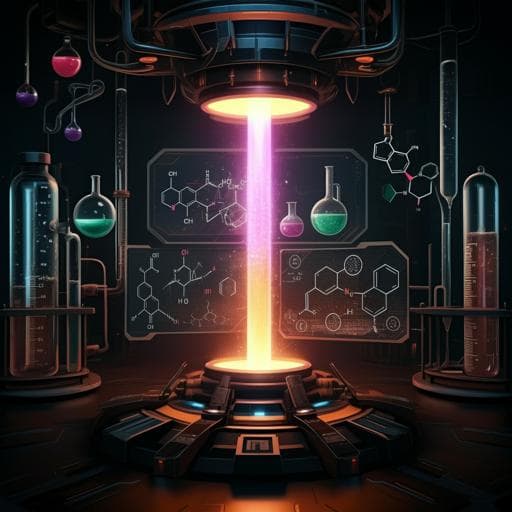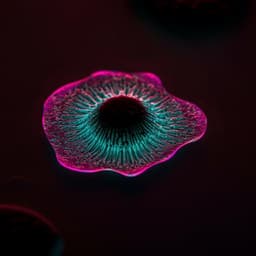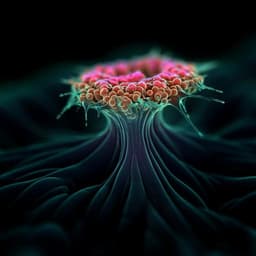
Chemistry
DigiChemTree enables programmable light-induced carbene generation for on-demand chemical synthesis
A. Rana, R. Chauhan, et al.
Discover how DigiChemTree revolutionizes chemical synthesis! This innovative AI platform optimizes photochemical reaction parameters in real-time, leading to faster and more efficient on-demand molecule synthesis. The groundbreaking research was conducted by Abhilash Rana, Ruchi Chauhan, Amirreza Mottafegh, Dong Pyo Kim, and Ajay K. Singh.
~3 min • Beginner • English
Introduction
The study addresses the challenge of poor reproducibility and slow optimization in light-induced reactions of diazo compounds used for carbene generation, which are important in organic synthesis and drug discovery. Traditional thermal-assisted and transition-metal-catalyzed carbene generation can suffer from low reactivity/selectivity, cost, impurity formation, and limited scalability. Photochemical carbene chemistry, despite academic advances, faces barriers such as the need for high-energy UV, costly optics, side reactions, low quantum efficiency, specialized reactors, and limited parameter control in conventional labs. To overcome these issues and enable industrially favorable, reproducible methods, the authors propose DigiChemTree: an AI-backed, continuous-flow photochemical platform that performs closed-loop, Bayesian optimization of key variables (e.g., light intensity, residence time, concentrations) to rapidly identify optimal conditions for diverse carbene insertion and coupling reactions, including late-stage functionalization.
Literature Review
The paper situates its contribution within extensive prior work on diazo chemistry and carbene transfer, including insertions into X–H bonds (O–H, S–H, N–H, Si–H), Wolff rearrangements, cyclopropanation/cyclopropenation, and cycloadditions. It notes limitations of earlier thermal and transition-metal-catalyzed approaches (cost, impurities, selectivity) and practical hurdles in photochemical implementations (UV requirements, reactor constraints, low quantum efficiency). It also references the emergence of autonomous reaction optimization and flow photochemistry, including Bayesian optimization and self-optimizing platforms for photoredox and other transformations, as well as the importance of multivariable control for reproducible and scalable synthesis. Collectively, this literature motivates integrating AI-driven optimization with continuous-flow photochemistry to accelerate methodology development and broaden synthetic utility, especially for late-stage functionalization and drug discovery.
Methodology
DigiChemTree integrates nine liquid delivery pumps, a PFA micro-flow tubular reactor, circular blue LED illumination with controlled power supply, affordable COM-port connectivity, a 3D-printer–converted solution collector, and in-line IR analysis in a closed-loop Bayesian optimization (BO) framework. In-line IR was first used to identify a product signature band (e.g., C=O at 1756–1775 cm⁻¹ for 4a). Stock solutions (typical: 0.1 M diazo substrate 2a; 0.2 M nucleophile/reagent) were prepared in appropriate solvents (EtOAc or DCE), loaded into syringes, and delivered to a T-mixer at BO-controlled flow rates to set stoichiometry and residence time. The mixture traversed a defined reactor volume (1 or 4 mL PFA) under blue LEDs at varied wattages and 3 bar backpressure. Reaction boundaries for flow rate, voltage/current (light power), and residence time were set; the BO loop began with three random experiments, then iteratively proposed single new conditions to maximize yield (quantified via in-line IR and checked by crude NMR; isolated yields reported for selected scopes). Typical daily throughput per optimization cycle was up to 62 experiments. Pre-optimized Python scripts were developed for specific reaction classes (AB1–AB7) covering: C–O insertion with carboxylates, C–S insertion with thiols, C–N insertion with amines, cyclopropanation of alkenes, cyclopropenation of alkynes, oxazole formation with nitriles, and cross-coupling of aryldiazoacetates with ethyl diazoacetate. For each transformation, BO optimized variables (concentrations, light power, residence time; sometimes reactor volume and solvent) within 24–48 h and tens of experiments (often ~44–84). The optimized conditions were used to run 5 h continuous-flow syntheses to collect gram-scale product. An integrated “Innovative DigiChemTree” consolidated AB1–AB7 into a single code (supplementary software 2) orchestrating pumps, reactor, in-line analytics, and collection for man-free, on-demand synthesis of a library (4a–16a). Methods and materials (reagents, tubing, reactor components) are provided; code is available on request.
Key Findings
- C–O bond formation (carboxylates, AB1): At 50 µL min⁻¹ each stream, 10 min residence, 68 ± 2 W, 3 bar, achieved 99% conversion; space-time yield (STY) 0.0909 g mL⁻¹ h⁻¹. Product scope (4a–4p) in 82–99% yields; 15 of 16 products (4b–4p) were newly reported. Benchmark batch had much lower STY (~0.0007 g mL⁻¹ h⁻¹) and longer times.
- C–S bond formation (thiols, AB2): Optimal at 5.3 min residence, 68 ± 2 W; 98% yield; STY 0.148 g mL⁻¹ h⁻¹ within 84 optimization cycles. 5 h run delivered gram-scale 6a. Batch required 24–48 h with metal catalyst and 35–89% yields. Flow scope (6a–6h) gave 75–98% yields; 6 of 8 products were new (6b–6d, 6f–6h).
- C–N bond formation (amines, AB3): BO over 24 h (44 experiments) identified 46 µL min⁻¹ each stream, 11 min residence, 68 ± 2 W, 3 bar: 92% max yield (8a); STY 0.058 g mL⁻¹ h⁻¹. Scope (8a–8j) 79–92% yields for aromatic and aliphatic amines.
- Cyclopropanation of alkenes (AB4): Optimal at 62 µL min⁻¹ each, 32 min residence, 68 ± 2 W, 3 bar: 95% conversion; STY 0.025 g mL⁻¹ h⁻¹. 0.01 mol scale in 5 h. Scope (10a–10i) 74–92% yields in 32 min; 3 of 9 products (10b, 10c, 10h) newly reported. Batch literature needs metal catalysts, 10–48 h, higher temperatures.
- Cyclopropenation of alkynes (AB5): After modifying residence time, optimal at 50 µL min⁻¹ each, 40 min, 68 ± 2 W, 3 bar: 96% yield; STY 0.020 g mL⁻¹ h⁻¹. Scope (12a–12h) 75–96% yields; 3 of 8 (12g, 12f, 12h) newly reported. Batch literature typically requires additional catalysts and longer times.
- Oxazole formation from nitriles (AB6): Fresh optimization in 24 h (44 experiments): 31 µL min⁻¹, 16 min, 68 ± 2 W, 3 bar: 91% conversion; STY 0.038 g mL⁻¹ h⁻¹.
- Cross-coupling with ethyl diazoacetate (AB7): 24 h (44 experiments): 40 µL min⁻¹, 12 min, 68 ± 2 W, 3 bar: 89% conversion for 16a; STY 0.058 g mL⁻¹ h⁻¹. Batch requires significantly longer times.
- Throughput: Closed-loop BO typically completed optimization within 24–48 h with tens of experiments; up to 62 experiments/day per cycle.
- Automation: Consolidated AB1–AB7 enabled man-free, on-demand synthesis of a library (4a–16a) in excellent isolated yields.
Discussion
DigiChemTree addresses the central challenge of rapidly identifying robust, reproducible conditions for light-induced carbene chemistry by combining continuous-flow photochemistry with closed-loop Bayesian optimization and in-line IR analytics. Across multiple reaction classes (X–H insertion, cyclopropanation/cyclopropenation, heterocycle formation, diazo–diazo coupling), the platform consistently delivered higher yields, dramatically improved space-time yields, and greatly reduced residence times versus conventional batch processes, often eliminating the need for metal catalysts. The ability to discover optimal conditions within 24–48 hours and immediately translate them to multi-hour continuous runs demonstrates significant process intensification and scalability. Integration of pre-optimized scripts into a single control program enabled autonomous, man-free late-stage functionalization and early-stage diversification, supporting SAR campaigns and de novo design. These advances highlight the platform’s relevance for industrially favorable, reproducible synthesis and for expanding accessible chemical space in medicinal chemistry.
Conclusion
The authors developed a “one code, one kind of reaction” DigiChemTree platform that autonomously optimizes and intensifies photochemical carbene transformations in continuous flow. Demonstrating adaptability across seven reaction families, the platform achieved significant yield and STY improvements over reported model conditions and enabled on-demand synthesis, including late-stage functionalization, without human intervention. The work reduces reliance on highly trained personnel and accelerates the creation of molecular libraries for medicinal chemistry. Future directions include releasing a human-interface software layer currently under development.
Limitations
The study does not explicitly enumerate limitations. Some reactions required fresh optimization, changes in solvent and reactor volume, or longer residence times (e.g., cyclopropenation vs. cyclopropanation), suggesting that generalization across reaction classes still entails re-optimization. The platform currently relies on a specific flow photochemical setup with in-line IR detection and blue LED sources, and user-friendly interface software is noted as ongoing work. Code is available upon request rather than fully open in the manuscript.
Related Publications
Explore these studies to deepen your understanding of the subject.



![Ag₃PO₄ enables the generation of long-lived radical cations for visible light-driven [2+2] and [4+2] pericyclic reactions](/_next/image?url=https%3A%2F%2Fd11tyujt19m6rg.cloudfront.net%2Fthumbnails%2Fmedium%2F595baea4ac4a1e4efa064e8fd092ea8fdc31cafa0914817d072799f8f0ed1f4626ccdc259ba1.jpg&w=256&q=75)



